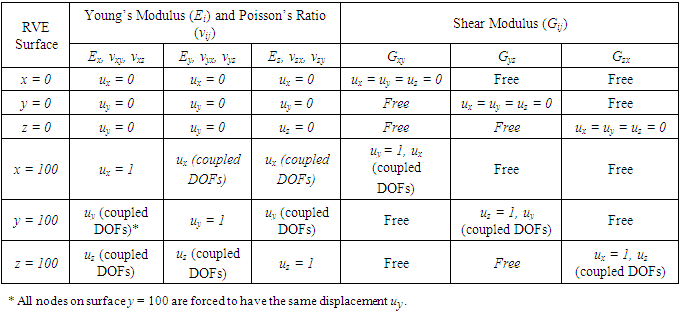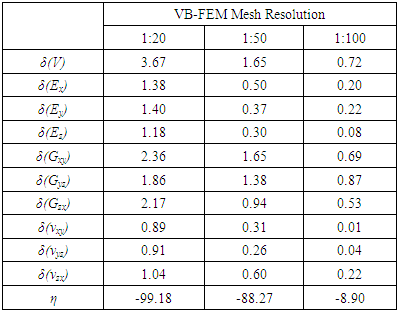-
Paper Information
- Paper Submission
-
Journal Information
- About This Journal
- Editorial Board
- Current Issue
- Archive
- Author Guidelines
- Contact Us
International Journal of Composite Materials
p-ISSN: 2166-479X e-ISSN: 2166-4919
2021; 11(3): 54-61
doi:10.5923/j.cmaterials.20211103.02
Received: Oct. 4, 2021; Accepted: Nov. 1, 2021; Published: Nov. 15, 2021

A Numerical Comparison between Geometry and Voxel Based Finite Element Modeling for Elasticity Characterization of Particulate Composites
Yunhua Luo
Department of Mechanical Engineering, University of Manitoba, Winnipeg, R3T 2N2, Canada
Correspondence to: Yunhua Luo, Department of Mechanical Engineering, University of Manitoba, Winnipeg, R3T 2N2, Canada.
| Email: |  |
Copyright © 2021 The Author(s). Published by Scientific & Academic Publishing.
This work is licensed under the Creative Commons Attribution International License (CC BY).
http://creativecommons.org/licenses/by/4.0/

Elasticity prediction based on phase properties is an important task in the analysis and design of composite materials. Microstructure-based finite element modeling of composite representative volume element (RVE) has a number of advantages over experimental and analytical methods for the task. However, there are a number of challenges in the conventional geometry-based finite element modeling (GB-FEM) of RVE, e.g. time-consuming in the construction of workable geometric models and in the generation of high-quality finite element meshes. To overcome these challenges, we developed a voxel-based finite element modeling (VB-FEM) procedure. In contrast to GB-FEM, VB-FEM first generates a uniform grid mesh and then identifies elements that belong to the inclusions. The rest steps are the same as those in GB-FEM. We compared the performance of GB-FEM and VB-FEM in two representative numerical examples. The results show that upon convergence, elasticity constants characterized by VB-FEM and GB-FEM have excellent agreement. Regarding their computational efficiency, although for the composite having regularly-distributed and large-size inclusions, GB-FEM is significantly more efficient than VB-FEM; However, for the composite having randomly-distributed and small-size inclusions, VB-FEM has similar and even higher efficiency than GB-FEM. Besides overcoming the mentioned challenges, VB-FEM has a number of additional advantages over GB-FEM. We conclude that VB-FEM is an effective tool for elasticity prediction of particulate composites.
Keywords: Particulate composite, Composite elastic property, Representative volume element, Finite element modeling, Geometry-based, Voxel-based
Cite this paper: Yunhua Luo, A Numerical Comparison between Geometry and Voxel Based Finite Element Modeling for Elasticity Characterization of Particulate Composites, International Journal of Composite Materials, Vol. 11 No. 3, 2021, pp. 54-61. doi: 10.5923/j.cmaterials.20211103.02.
Article Outline
1. Introduction
- Particulate composite materials are widely used in industrial products and engineering structures due to their merits such as easy-to-manufacture, customized mechanical properties and great flexibility of design. Prediction of composite elasticity constants based on phase properties is a key task in the design of various composite materials. There are primarily three categories of methods available for the prediction of composite properties, i.e. mechanical testing [1-3], analytical micromechanics models [4,5] and finite element modeling of representative volume element (RVE) [6-9]. Mechanical testing is direct and reliable, but it is also time-consuming and expensive. Micromechanical models are the most efficient and convenient ones, because they offer analytical expressions. Nevertheless, they are usually based on special assumptions, for example dilute dispersion. Therefore, they have limited accuracy for composites that do not strictly satisfy the assumptions, e.g. composites that have large contrast of phase properties and high volume-fraction of inclusions [5]. Finite element modeling of RVE has the merits of both mechanical testing and micromechanical models, but avoids their drawbacks. Therefore, finite element modeling of RVE is widely applied in the study and design of composite materials [10-14].There are basically two types of finite element modeling approaches available for elasticity prediction of composite materials, one is geometry based [10,15], the other is voxel based [16,17]. Take particulate composite as an example, in geometry-based finite element modeling (GB-FEM), a geometric model of the microstructure of RVE, which includes matrix and inclusions, is first constructed; Material properties are assigned to the matrix and the inclusions; A finite element mesh is then generated from the geometric model; Appropriate loading and constraint conditions are applied for the characterization of various elastic properties. Although theoretically geometry-based finite element modeling is an ideal tool for composite property prediction, there are a number of practical challenges. The first one is in the construction of a workable RVE geometric model [10,18]. Inclusions in actual composites are random distributed and have different geometric shapes and sizes. Inclusions (e.g. two spheres) that are infinitely close to each other may result in severely distorted and even degenerated geometric entities. This kind of geometric model is difficult to create even with relaxed geometric tolerances. Even with a valid RVE geometric model, there are still challenges in the generation of high-quality finite element meshes [19,20]. The existence of distorted and degenerated geometric entities may first fail the generation of a finite element mesh and then may result in severely distorted finite elements. Mesh quality significantly affects the accuracy of finite element solutions. To improve mesh quality, adaptive meshing has to be used [20], which is time-consuming but still cannot guarantee the quality.Voxel-based finite element models (VB-FEM) constructed from quantitative computed tomography (CT) or micro-CT are often used in the study of bone mechanical properties [17,21-23]. The main difference between VB-FEM and GB-FEM is in the generation of finite element mesh. In contrast to GB-FEM, where a finite element mesh is generated from a geometric model, VB-FEM directly converts voxels in digital images into brick elements. Another advantage of VB-FEM is that material properties are reflected in voxel intensity or Hounsfield Unit (HU), which provides realistic information on the distribution of inhomogeneous bone density. There are two major concerns about VB-FEM. One is its computational efficiency. Since digital images usually consist of a large number of voxels, the resulting finite element meshes usually consist of a huge number of elements. The other concern is the non-smoothness of model boundaries, which may introduce stress concentration.Despite of the above concerns, VB-FEM avoids the difficulties of GB-FEM in the creation of geometric model and in the generation of high-quality mesh. Voxel-based finite element meshes always have good quality. For the above reasons, we are motivated to compare the accuracy and efficiency of GB-FEM and VB-FEM in elasticity prediction of particulate composites, to study the possibility of using VB-FEM in elasticity prediction of particulate composites to avoid the difficulties of GB-FEM.
2. Materials and Methods
- To compare their performance, GB-FEM and VB-FEM are constructed from the same composite RVE as illustrated in Figure 1. In GB-FEM, the matrix and the inclusions are meshed separately. A number of issues are introduced by this strategy, which has been discussed before. In contrast, for VB-FEM a uniform grid mesh is first generated for the whole domain occupied by the RVE. Then, the information of inclusion location and size in the RVE are used to identify the elements that belong to the matrix and the inclusions respectively. The resulting finite element mesh with distinguished Table 1 matrix and inclusions looks like a binary digital image, therefore, the terminology of voxel is used. As it will be shown later, the resolution of VB-FEM mesh, defined as the ratio between element size and the RVE size, affects the accuracy of VB-FEM. The rest steps of finite element analysis, including assignment of material properties and application of loading and constraint conditions, are the same as in GB-FEM. The objective of this comparison study is to find out whether or not GB-FEM and VB-FEM have good agreement upon their convergence, and what are their relative computational efficiency.
|
 | Figure 1. Construction of GB-FEM and VB-FEM from the same composite RVE |
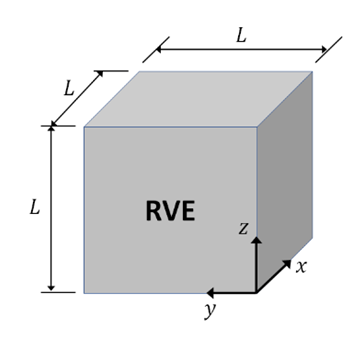 | Figure 2. Cubic RVE and coordinate system |
 , Poisson’s ratio
, Poisson’s ratio  and shear modulus
and shear modulus  . The applied constraint conditions are intended to mimic the behavior of the RVE in a larger material body and to avoid ‘artificial’ stress concentration. Take Young’s modulus
. The applied constraint conditions are intended to mimic the behavior of the RVE in a larger material body and to avoid ‘artificial’ stress concentration. Take Young’s modulus  as an example, the RVE surfaces at x = 0, y = 0 and z =0 are constrained in x, y and z direction, respectively; a uniform displacement is introduced on surface x = L; the surfaces y = L and z = L are forced to have uniform displacement from Poisson’s effect.After the solution of the finite element equations, RVE Young’s modulus, Poisson’s ratio and shear modulus are determined by the homogenization theory based on volume-averaged stresses and strains [24-26], i.e.
as an example, the RVE surfaces at x = 0, y = 0 and z =0 are constrained in x, y and z direction, respectively; a uniform displacement is introduced on surface x = L; the surfaces y = L and z = L are forced to have uniform displacement from Poisson’s effect.After the solution of the finite element equations, RVE Young’s modulus, Poisson’s ratio and shear modulus are determined by the homogenization theory based on volume-averaged stresses and strains [24-26], i.e. | (1) |
 | (2) |
 | (3) |
 | (4) |
 , and
, and  are respectively the normal stress, normal strain, shear stress and shear strain determined by the finite element analysis; V is the volume of RVE.Agreement between GB-FEM and VB-FEM is measured by the following normalized difference,
are respectively the normal stress, normal strain, shear stress and shear strain determined by the finite element analysis; V is the volume of RVE.Agreement between GB-FEM and VB-FEM is measured by the following normalized difference, | (5) |
 is the elastic property predicted by GB-FEM upon convergence;
is the elastic property predicted by GB-FEM upon convergence;  is the property obtained by VB-FEM with a certain mesh resolution. A smaller δ value indicates a better agreement between GB-FEM and VB-FEM; If δ = 0, there would be no difference.To compare computational efficiency of GB-FEM and VB-FEM, normalized number of nodes (η) is used, which is defined as
is the property obtained by VB-FEM with a certain mesh resolution. A smaller δ value indicates a better agreement between GB-FEM and VB-FEM; If δ = 0, there would be no difference.To compare computational efficiency of GB-FEM and VB-FEM, normalized number of nodes (η) is used, which is defined as | (6) |
 and
and  are respectively the number of finite element nodes in VB-FEM and GB-FEM. If η > 0, more nodes are used in VB-FEM than in GB-FEM; otherwise less nodes are used.
are respectively the number of finite element nodes in VB-FEM and GB-FEM. If η > 0, more nodes are used in VB-FEM than in GB-FEM; otherwise less nodes are used.3. Numerical Examples and Results
- A polymer filled with small glass spheres [3] is selected for this comparison study. The polymer (matrix) has Young’s modulus
 = 2.68 GPa and Poisson’s ratio
= 2.68 GPa and Poisson’s ratio  = 0.394; The glass spheres (inclusions) have Young’s modulus
= 0.394; The glass spheres (inclusions) have Young’s modulus  = 70.0 Gpa and Poisson’s ratio
= 70.0 Gpa and Poisson’s ratio  = 0.23. Two types of RVE of the composite, as shown in Figure 3 and Figure 4, are constructed to compare GB-FEM and VB-FEM. RVE 1 in Figure 3 has large size and regularly distributed spheres, while RVE 2 in Figure 4 has small size and randomly distributed spheres.
= 0.23. Two types of RVE of the composite, as shown in Figure 3 and Figure 4, are constructed to compare GB-FEM and VB-FEM. RVE 1 in Figure 3 has large size and regularly distributed spheres, while RVE 2 in Figure 4 has small size and randomly distributed spheres.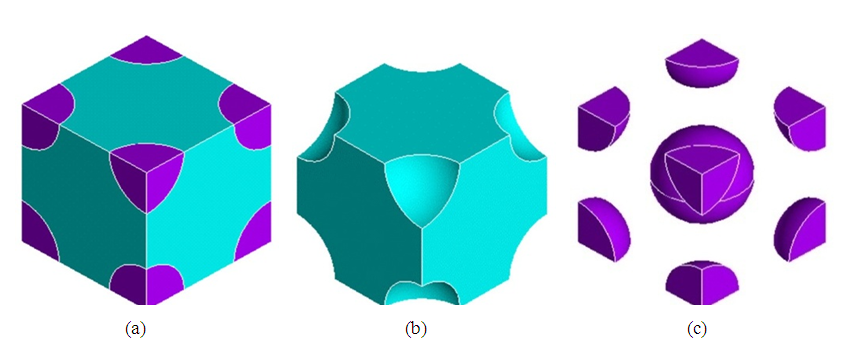 | Figure 3. RVE 1: regularly-distributed and large-size spheres. (a) composite; (b) matrix; (c) inclusions |
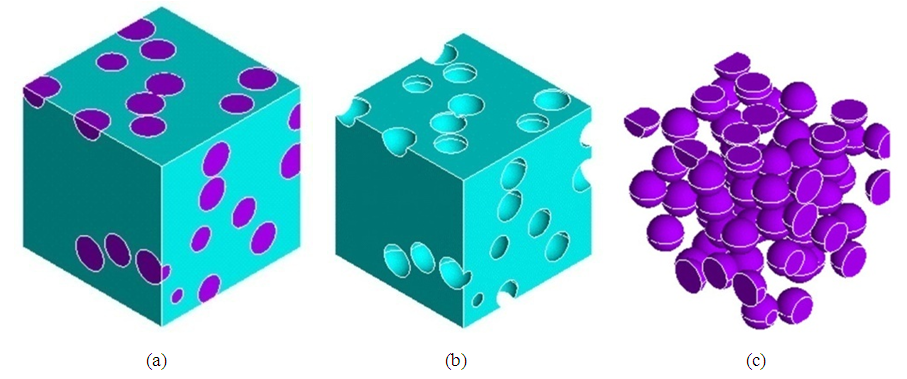 | Figure 4. RVE 2: randomly-distributed and large-size spheres. (a) composite; (b) matrix; (c) inclusions |
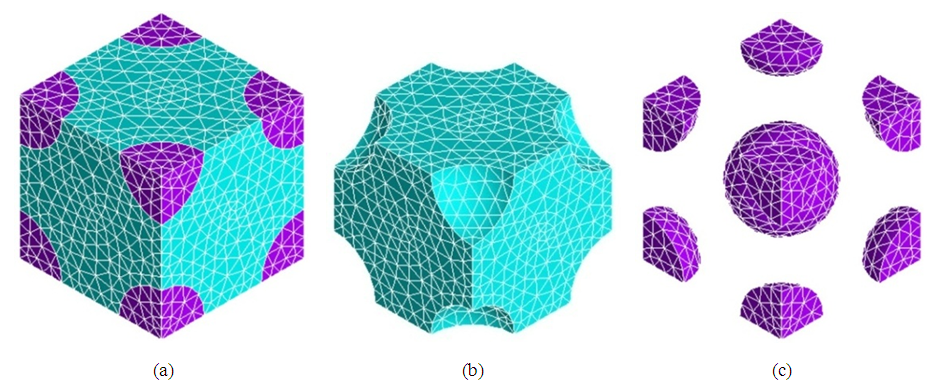 | Figure 5. GB-FEM of RVE 1. (a) whole model; (b) matrix; (c) inclusions |
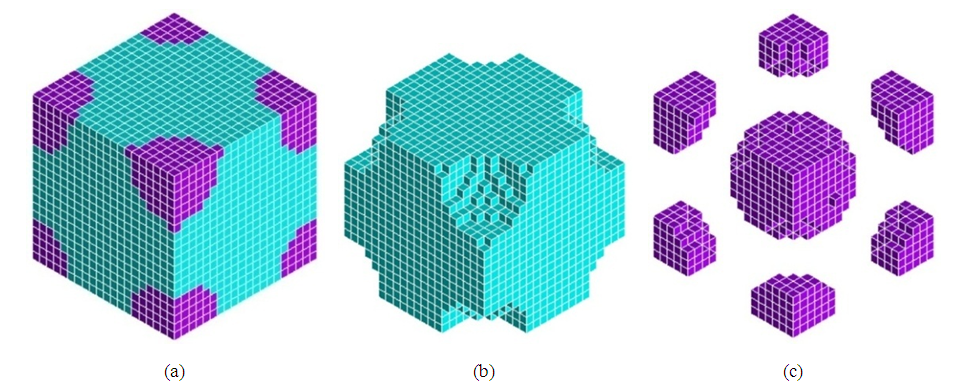 | Figure 6. VB-FEM of RVE 1. (a) whole model; (b) matrix; (c) inclusions |
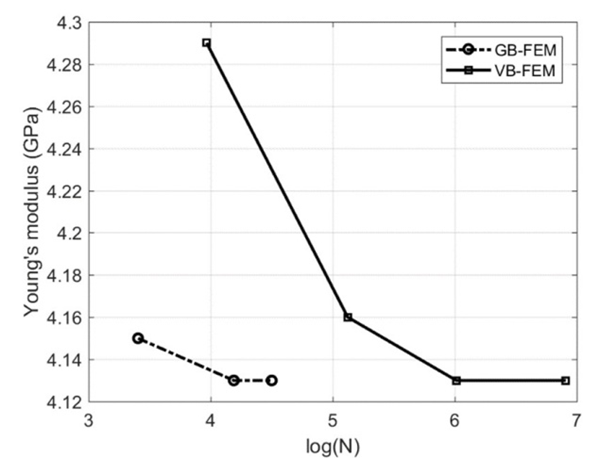 | Figure 7. Variation of RVE Young’s modulus with number of nodes (RVE 1) |
|
|
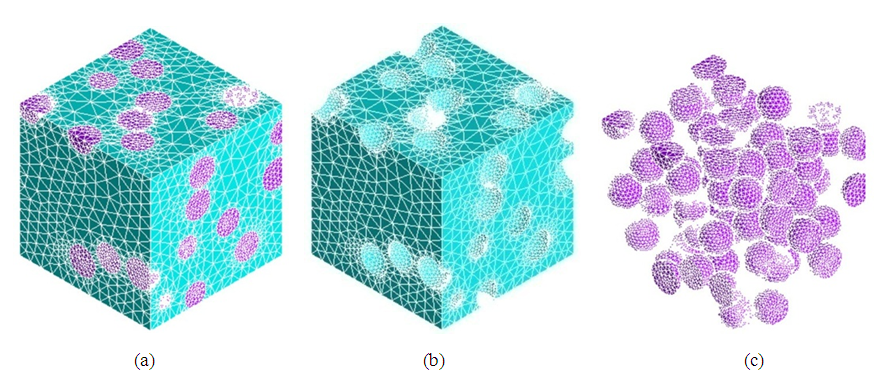 | Figure 8. GB-FEM of RVE 2. (a) whole model; (b) matrix; (c) inclusions |
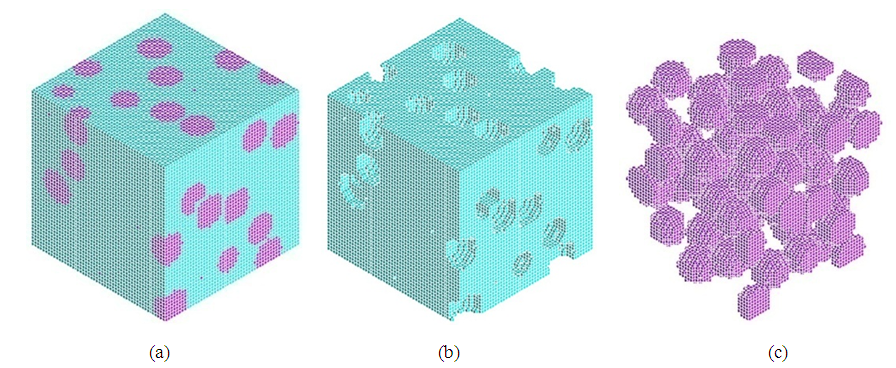 | Figure 9. VB-FEM of RVE 2. (a) whole model; (b) matrix; (c) inclusions |
 | Figure 10. Variation of RVE Young’s modulus with number of nodes (RVE 2) |
4. Discussion and Conclusions
- The results of this comparison study show that for the elasticity prediction of particulate composites, GB-FEM and VB-FEM have similar accuracy upon their convergence. Regarding their computational efficiency, for a composite with large size and regularly distributed inclusions (e.g. RVE 1), GB-FEM has obvious advantage over VB-FEM; but for a composite with small size and randomly distributed inclusions (e.g. RVE 2), which is more often encountered in engineering, VB-FEM and GB-FEM have similar computational efficiency. Nevertheless, VB-FEM avoids all the difficulties of GB-FEM that have been discussed at the beginning of this paper. In addition, VB-FEM has a number of other advantages over GB-FEM. For the creation of VB-FEM, the only requirement is nonoverlap among inclusions, which is much easier to satisfy than the creation of a workable geometric model in GB-FEM. There is no restriction on how close two inclusions can be in VB-FEM; therefore, a high volume-fraction of inclusion can be achieved more easily. The accuracy and computational efficiency of VB-FEM are not affected by the number and the size of inclusions in the composite, as can be seen from the results of RVE 1 and RVE 2 obtained by VB-FEM. However, GB-FEM has to greatly increase the number of elements, because a large number of small-size elements are required to realistically represent the small inclusions and to fill in the very narrow gaps between infinitely close inclusions. If the volume fraction of inclusions is high, the situation will become even worse for GB- FEM [27].Although GB-FEM and VB-FEM have similar accuracy in the prediction of composite elastic properties, there exist significant differences in the stresses and strains determined by the two models. Figure 11 (a) and (b) show the patterns of von-Mises (v-M) stress distribution produced by GB-FEM and VB-FEM for RVE 1 respectively. Quantitative differences can be observed from the results listed in Table 4.
|
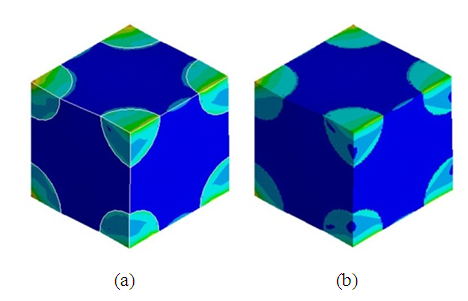 | Figure 11. Von-Mises stress distribution in RVE 1. (a) GB-FEM; (b) VB- FEM |
ACKNOWLEDGEMENTS
- The reported research has been supported by Natural Sciences and Engineering Research Council (NSERC) of Canada in grant RGPIN-2019-05372, which is gratefully acknowledged.
 Abstract
Abstract Reference
Reference Full-Text PDF
Full-Text PDF Full-text HTML
Full-text HTML